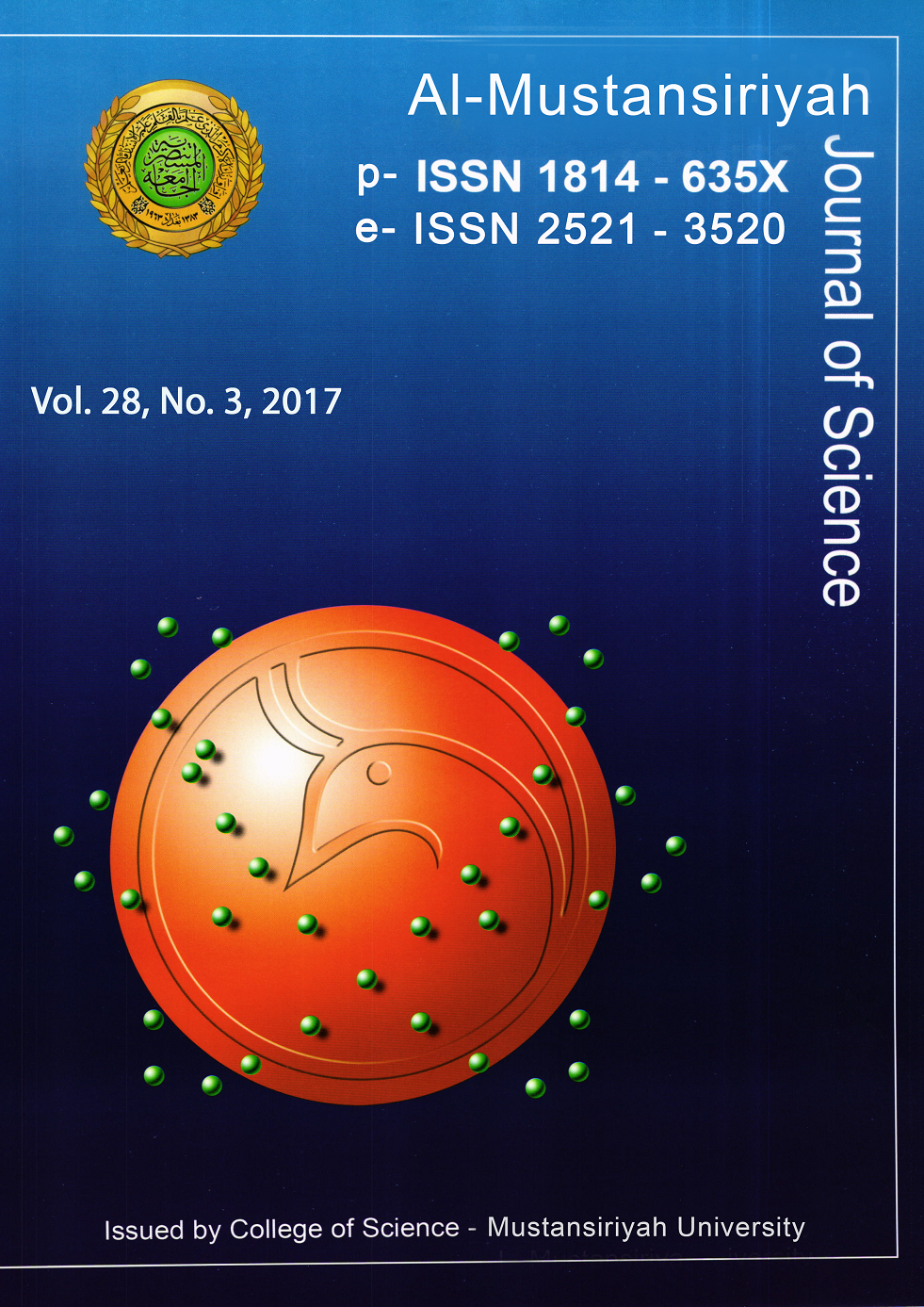Antimicrobial Effect of Acacia Nilotica on Some Gram Positive and Gram Negative Bacteria
DOI:
https://doi.org/10.23851/mjs.v28i3.542Keywords:
Antimicrobial effect, fruits and seeds extract, Acacia niloticaAbstract
Acacia nilotica is a plant has an inspiring range of medicinal uses. This plant contributes a number of groups among which are alkaloids, volatile essential oils, phenols and phenolic glycosides, resins, oleosins, steroids, tannins and terpenes, this study aims to: examine the antimicrobial action of ethanolic extraction from fruits and seeds of Acacia nilotica. Hot ethanol extract (48°C) of fruits and seeds obtained from Acacia nilotica, used in minimum bactericidal concentration (MBC), agar diffusion method to detect the antibacterial effect of the extract. Elucidate almost for all bacterial types used in this study, the concentration of 100mg/ml was the mostly effective concentration on bacteria (Staphylococcus aureus, Streptococcus pneumonia, and Proteus mirabilis); while the E. coli and Pseudomonas aeruginosa the concentration of 75 mg/ml was the effective concentration for both of them as an optimum concentration.Downloads
References
Ivanova, D., D. Gerova T. Chervenkov and T.Yankova: Polyphenols and antioxidant capacity of Bulgarian medicinal plants.J.Ethnophrmacol.,2005,96:145-150.
Gill LS. Ethanomedicinal uses of plants in Nigeria. University of Benin Press, Benin City, Nigeria.2009, pp.10-30.
Kagithoju S, Godishala V, Pabba SK, Kurra HB, Swamy R:Anti bacterial activity of flower extract of Pongamia pinnata linn –An elite medicinal plant. Int J Pharmacy and Pharmaceutical Sci,2012 ,4(3): 130-132.
Neelavathi P, Venkatalakshmi P, Brindha P. :Antibacterial activities of aqueous and ethanolic extracts of Terminalia catappa leaves and bark against some pathogenic bacteria. Int J Pharmacy and Pharmaceutical Sci;2013,5(1): 114-120.
Basile A, Sorbo S, Giordano S, Ricciardi L, Ferrara S,and Montesano D. :Antibacterial and allelopathic activity of extract from Castanea sativa leaves. Fitoterapia; 2000,71:.110-116.
Kalaivani T,and Mathew L: Phytochemistry and free radical scavenging activities of Oroxylum indicum. Environ We Int J Sci Tech;2000, 4: 45-52.
Rice-Evans C,: Flavonoids and isoflavones: absorption, metabolism, and bioactivity. Free Radical Biology and Medicine;2004, 36: 827-828.
Dixon R, Xie D,and Sharma S.: Pro anthocyanidins: a final frontier in flavonoid research. New Phytologist; 2005,165: 9-28.
Jayaprakasha G,and Patil B.: In vitro evaluation of the antioxidant activities in fruit extracts from citron and blood orange. Food Chem; 2007,101: 410-418.
Kviecinski M, Felipe K, Schoenfelder T, de Lemos Wiese L, Rossi M.: Study of the antitumor potential of Bidens pilosa (Asteraceae) used in Brazilian folk medicine. J Ethnopharmacol; 2008,117: 69-75.
Singh BN, Singh BR, Singh RL, Prakash D, Sarma BK ,and Singh HB :Anti oxidant and antiquorum sensing activities of green pod of Acacaia nilotica L. Food Chem. Toxicol. ,47 : 2009a, 778786.
Singh BN, Singh BR, and Singh BK, Singh HB. : potential chemo prevention of Nnitrosodiethylamine induced hepato carcinogenesis by polyphenolics from Acacia nilotica bark. Chem-Biol. Interact., 2009b 181:20-28.
Del WE :In vitro evaluation of peroxylradical scavenging capacity of water extract of Acacia nilotica (L) Afr.J.Biotechnol.,2009, 8(7):12701272.
Gilani AH, Shaheen F, Zaman M, Janbaz KH, Shah BH,and Akhtar MS.: Studies on antihypertensive antispasmodic activities of methanol extract of Acacia nilotica pods.1999,13:665-669.
Raghavendra MP, Satish S, and Raveesha KA: In vitro evaluation of anti-bacterial spectrum and phytochemical analysis of Acacia nilotica. J Agri Tech;2006, 2: 77–88.
Ogbadoyi EO, Akinsunbo OA, Adama TZ,and Okogun JI: In vivo trypanocidal activity of Annona senegalensis Pers. leaf extract against Trypanosoma brucei brucei. Journal of Ethnopharmacology, 2007,112: 85-89.
Hsueh PR, Chen ML, Sun CC, Chen WH, Pan HJ, Yang LS, Chang SC, Ho SW, Lee CY, Hsieh WC,and Luh KT. :Antimicrobial drug resistance in pathogens causing nosocomial infection at a University Hospital in Taiwan, 1981- 1999. Emerging Infectious Diseases,2002, 8: 63-68.
Boakye-Yiadom, K., N.I. Fiagbe and J.S. Ayim,: Antimicrobial properties of some West African medicinal plants iv. Antimicrobial activity of xylopic acid and other constituente of the fruits of Xylopia aethiopica (Annonaceae). Lloydia,1977, 40: 543-545.
Al-Sudanii Astabraq A.:Effect of Quercus sp. Fruit pericarp extractor growth in Iraq on dental caries bacteria. 2004,Thesis of master of science.
Al-Yahya, M.A., I.A. Al-Meshal, J.S. Mossa, A.A. Al-Badr and M. Tariq,. Saudi Plants: A Phytochemical and Biological Approach. 1st Edn. King Saud University Press, Riyadh, Saudi Arabia,1994, pp: 142-144..
Sotohy, S.A., W. Muller and A.A. Ismail. In vitro effect of Egyptian tannin-containing plants and their extracts on the survival of pathogenic bacteria. Dtsch Tierarztl Wochenschr, 1995,102: 344-348.
Saini M. L., Saini R. , Roy S. and Kumar A.: Comparative pharmacognostical and antimicrobial studies of acacia species (Mimosaceae) .Journal of Medicinal Plants Research,2008,Vol. 2(12), pp. 378-386.
Abeer M. Haj Ali and Sanaa O. Yagoub: Anti-microbial Activity of Acacia nilotica Extracts Against Some Bacteria Isolated from Clinical Specimens. Research Journal of Medicinal Plants,2007,1: 25-28
El-Shanawany, M.A.A.:Medicinal plants used in Saudi traditional medicine. King Abdel Aziz City for Science and Technology, 1996, Riyadh.
Aboaba, O.; and Efuwape, B.M., Antibacterial Properties of Some Nigerian Species. Bio. Res. Comm., 2001, 13, 183-188.
Dorai, T.; and Aggarwal, B.B.: Role of Chemopreventive Agents in Cancer Therapy. Cancer Lett.,2014, 215, 129-140.
Downloads
Key Dates
Published
Issue
Section
License
(Starting May 5, 2024) Authors retain copyright and grant the journal right of first publication with the work simultaneously licensed under a Creative Commons Attribution (CC-BY) 4.0 License that allows others to share the work with an acknowledgement of the work’s authorship and initial publication in this journal.






















